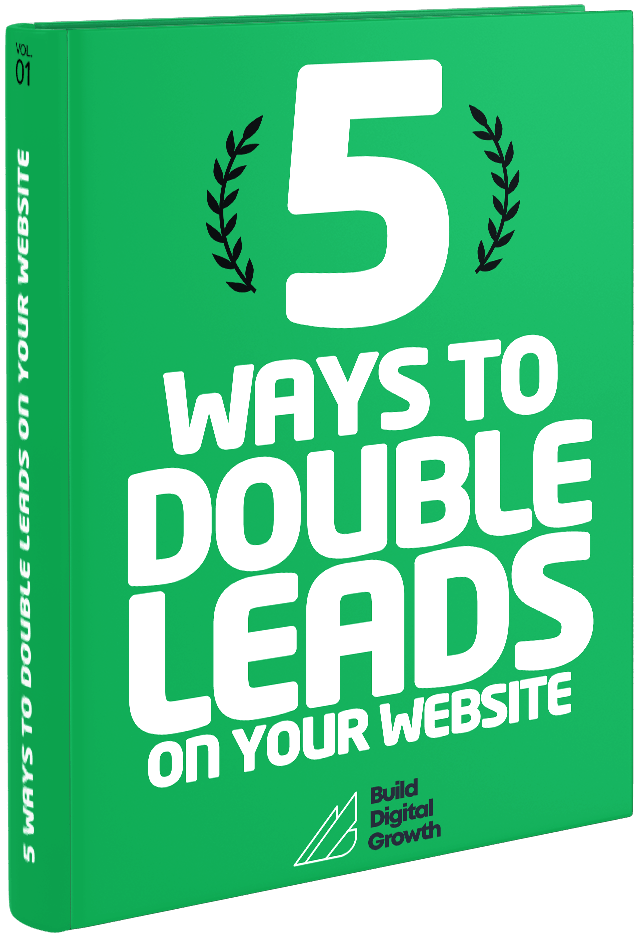If you are looking for a web design approach that can deliver results and bring measurable value to your business, the answer lies in a Growth-Driven Design. What is Growth-Driven Design and how can it produce better results and grow your business?
Growth-Driven Design is the smarter, more agile, and data-driven approach that minimizes the errors that traditional web design makes. It creates a huge potential for you and your business so you shouldn’t even think twice about having a web design or redesign using this innovative, growth-driven approach.
Why Traditional Web Design is Heading Out the Door
Your website plays more roles than you realise.
- It is your best marketing asset and centerpiece of your marketing activities.
- It is where you drive all your marketing efforts.
- It is the first place that prospects go to when looking for information about your products or services.
- It is your best salesperson.
Now let’s take a look at the traditional website design process.
- Large up-front cost – An average website typically costs between $15k and $80k upfront.
- Requires significant time and resource – An average small to medium-sized business (SMB) website typically takes three months to complete and requires a lot of resources and energy from the design team. Not only that. It has no scaleable results to show until it gets launched.
- Unpredictable – Most web dev projects are over budget, not on time, and not flexible which can push back any potential ROI.
- Subjective designs with no performance guarantee – You will be held accountable for a measurable increase in a result which you have no control over.
After its launch, a website typically sits idle with no updates for 1.5 to 2 years. How can you let something you’ve spent all your time and budget on remain unchanged for years? If you do small improvements like adding blogs or landing pages, well, they don’t count.
Accept the Fact That Change is Constant
Now that you’ve been enlightened, the time has come to embrace a quick and agile web design that produces better results and ROI. This is where Growth-Driven Design comes in. It is a completely new approach and way of thinking when it comes to building and growing your website.
Growth-Driven Design has its benefits:
- Lessens the risks associated with traditional web design – With the systematic approach to web design that shortens the time to launch, you can focus on the real impact it produces and work from there.
- Continuous learning and improvement – Constant research, testing, and learning about visitors can promote improvements and peak performance.
- Disseminate learnings to other channels – Growth-Driven Design is closely integrated with marketing and sales so as soon as you get new user data, you can immediately share it with them, and vice versa.
Stages of Growth-Driven Design Phase One
Now, how do you approach a Growth-Driven Design? Let’s divide the approach into two phases and here are the three stages you have to follow for phase 1:
Come up with your strategy
This is where you set a solid foundation to build your Growth-Driven Design taking into consideration the following:
- Goals – Decide on what you want to achieve with your website, what you’d like to improve from the previous one, and assess its impact on the marketing department’s goal.
- Personas – Research and develop a detailed representation of the different types of visitors or personas that you want to attract to your site. This is very important since Growth-Driven Design is user-centered. You can group your personas based on the characteristics that your audience shares such as job title, industry, etc.
- Quantitative Research | Website & Analytics Audit – Measure the performance of your existing website to see what’s working and what’s not. From here, you should be able to see where your users are dropping off which can help you make improvements.
- Qualitative Research | User Research – Reach out to your existing users and learn more about them. It will be useful to understand who they are and engage with them. This will also provide you with more information for your persona profiles.
- Fundamental Assumptions – Gather all the information together and form the fundamental assumptions about your users which are important in explaining their behavior and motivations. This will then help you in global and page strategy as well as for future Growth-Driven Design cycles. Make sure to include assumptions such as:
- The location and devices that they will be accessing your website from
- The value proposition for each service, product, and offer
- What information they are looking for
- Global and Page Strategy – Develop a global strategy for the website as a whole as well as a specific page-by-page strategy for each major page on your website. Incorporate all of the previous steps and layout exactly how to best engage and influence the user in both strategies.
Create a wishlist
Next, you come up with a wishlist using your strategy takeaways together with your team. Set your existing website aside and brainstorm for creative and innovative ideas that will create an impact on your site. Include the following factors:
- Your website section and pages
- Marketing assets, tools, and resources
- Modules, functionality, and special features
- Elements of design
- Changes in experience based on devices, location, etc.
You are not expected to implement all the ideas you have come up with at once. Some may even remain to be a “wish”. The important thing is to gather all your goals together setting aside money, time, and development skill issues. This will help you in implementing your strategy and you can add or remove items as you go along.
- Run the Pareto Principle or 80/20 analysis on your wishlist – Go back to your wishlist and determine which items you want to first implement on your LaunchPad website. Identify 20% of the items that will produce 80% of the impact and value for your website’s users. Then filter the wants and the needs and prioritize the needs, sending the wants back to the wishlist. Narrow your focus to the needs since these will create the most impact on your website.
- Create hypothesis statements for each core action item – Creating a hypothesis statement will help you clearly see how each action item can affect your goals, the personas you’re targeting, and your expected results. You can consider the following:
- Expected Impact – This is the value — a single number — your visitors will get from the action item and the impact it will have on your goal.
- Effort Required – This value — a single number — represents a combination of the number of hours, resources, and difficulty to implement a particular action time.
- Metrics Measured – Here, you come up with all the specific metrics that you will need to test the action item and evaluate the correctness of your hypothesis.
- Definition of Complete – How would you determine if the action item completed? Figure out the factors which will be very helpful in erasing doubts in the future — when reviewing results or efficiency.
- Web implementation process – Once you have identified the most critical action items to include on your Launch Pad site, you can run them through the standard website implementation process including:
- Messaging and content
- User experience (UX) and site architecture
- Inbound marketing strategy alignment
- Wireframes
- Designs
- Development
- Quality assurance and testing
- Set up data collection – Setting up data collection can help you learn about your visitors once your Launch Pad site is live. Consider the following when collecting data:
- Your goals as defined in the strategy phase
- Your fundamental assumptions
- Your hypothesis statement
Stages of Growth-Driven Design Phase Two
As previously discussed, once you have launched your Launch Pad website, continuous improvement starts. Your wishlist should be re-evaluated, implemented, and updated regularly. They should revolve around your personas, providing value to each of them who visits your site. To make sure you don’t skip a step, follow these:
Plan
Identify the most impactful items to implement. To do this, you must identify the following:
- Review the performance and goals – Review the current performance of your website and compare that to your goals. This will help you identify where to improve on.
- Conduct additional research and gather more data – This will help you see if you need to add more action items to your wishlist. Ponder on this while reviewing your performance and goals.
- Collaborate with the marketing and sales team – Ask the marketing and sales teams if they learned something new about the target personas which you can turn into action items. For example, they might have launched a blog that yielded a lot of organic and social visitors. That particular well-received topic is a gem of information that you can use in your Growth-Driven Design program.
- Hold another brainstorming session and prioritize your wishlist – Based on all the new information you have gathered, another brainstorming session will help you determine any new action items to add to your wishlist.
Your action items should do the following:
- Boost conversion – These include conversion points, user path, testing value props, and split testing which are directly related to conversion rate optimization.
- Improve user experience – These include navigation, UI improvements, and mobile experience. The goal here is to give the user a better experience, make it easier for them to navigate, find what they are looking for, and solve their problems.
- Personalized to the user – Here, you adapt your site, calls-to-action, content offers, etc. to the interests, device or country, and previous actions that occurred on your site.
- Build marketing assets – These include tools, marketing resources, and SEO-focused assets that will help provide value to the end-user and your company.
- General updates on your website – Update your website with new information that comes up from time to time. These can also be added to your wishlist.
Prioritise your wishlist to high, medium, and low based on their impact on the goal of the website and value to the user. Pick the one with the most impact and implement it then you can go back for another!
Develop – Get everyone on the team working and start implementing your most impactful items on the site. Each of these action items should be considered an experiment to see the impact it has on the performance of the website. Measure your experiments by setting up validation tracking around the metrics outlined in the action item. Once your experiment goes live on the site, develop a marketing campaign such as blogging to drive traffic to that section and start collecting data. During this time, build and schedule that marketing campaign with your marketing team.
Learn – Review the data you collected about your visitors then use the information to validate or disprove the hypothesis on your action item card. Disseminate the positive information to everyone within the organization using a structured system for publishing. This way, you can easily reference back to it.
Transfer – In this last step, you have to transfer all relevant information to other parts of your business. Look for useful patterns and proofs that they can implement in their activities. Put your recommendations together, host a meeting, and brainstorm for ways to integrate and translate the ideas into fruition.
Repeat everything
Now that you’re able to successfully complete a cycle, go back to the beginning and plan the next one. Your goal is to get better results and more insights about your visitors with each cycle. Keep in mind that the more cycles you complete, the more impact it will have on your website.
Adopting the flexible Growth-Driven Design methodology has produced huge success to companies utilising it. Growth-Driven Design is the smarter approach to your website so start implementing it now.










